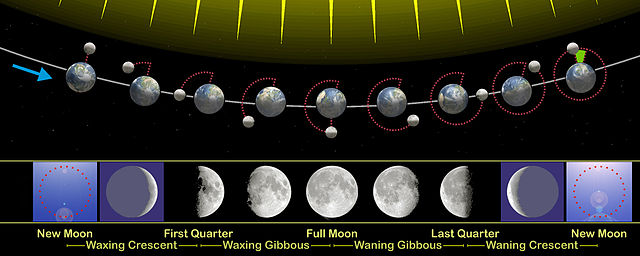English Across the Curriculum
The Solar System
The Moon
The moon is the Earth's natural satellite and the object in space that is closest to us. It has a diameter of about 3,400 km - only about one quarter of the Earth's. Gravity on the moon is only one sixth of the Earth's. You would be very light on the moon. A person who has a weight of 60 kg would weigh only ten kg on the moon.
The moon moves around the earth at an average distance of about 400,000 km and at a speed of 3,700 km an hour. It completes one orbit around the Earth every 27 days and 8 hours. It takes the moon the same time to rotate around its own axis. That means that the same side of the moon is pointed towards us all the time. Whenever you look at the moon you will always see the same face. Nobody, other than astronauts, has seen the other - the dark side - of the moon.
The moon has no atmosphere. There is nothing to breathe, not even poisonous gases and there is no weather to change its surface. Temperatures on the moon are very extreme. They range from 125 ° C when the sun shines on the lunar surface down to -175 °C on the dark side of the moon.
We can see the moon in different phases as it travels around the Earth. Half of the moon is always in the sunlight just as half of the earth has day while the other half has night. The phases of the moon depend on how much of the sunlit half can be seen from the Earth.
- Phase 1 : New Moon - The face of the moon is completely in shadow.
- Phase 2 : Half Moon - Half of the sunlit side of the moon can be seen from the Earth.
- Phase 3 : Full Moon - The moon shows its fully lit surface.
- Phase 4 : Half Moon - The moon appears as a half-circle again .
Ancient observers of the moon saw dark areas, which they thought were great oceans. They gave them the Latin word "mare", which means sea. Today we know that the moon has great flat areas (mare) that are thousands of km wide, but it also has craters and mountains that are very high. The craters come from the impact of asteroids early in the moon's history. Not very much has changed the surface of the moon for the last 3 billion years. The largest crater is almost 300 km wide and 4,000 m deep. The highest mountains are almost as high as the Himalayas on Earth.
Before astronauts landed on the moon, there were many theories about how the moon was formed. But today, after scientists have studied moon rocks for almost 50 years, most of them think there is only one theory left.
Over 4 billion years ago, the Earth was hit by a large object, maybe the size of the planet Mars. The crash blasted parts of the Earth and what was left of this planet into an Earth orbit. As time went on all of the parts that were flung into space joined together to form the moon.
Our tides ( high tide and low tide) happen because the moon pulls at the Earth. When the moon is directly over a certain place on the earth the water rises higher than it normally does, sometimes up to 10 meters . In other places, the water level is lower than it usually is. High and low tides usually take place twice a day.
The moon is the only object in space that human beings have visited. In 1969, the American Apollo 11 spacecraft landed on the moon and two astronauts - Neil Armstrong and "Buzz" Aldrin - became the first people to set foot on the moon. Between 1969 and 1972 there were six landings on the moon. But in the last 40 years nobody has visited it.

